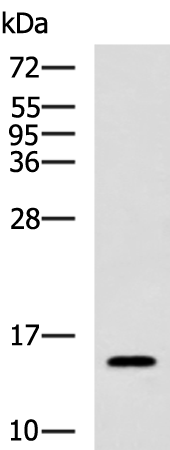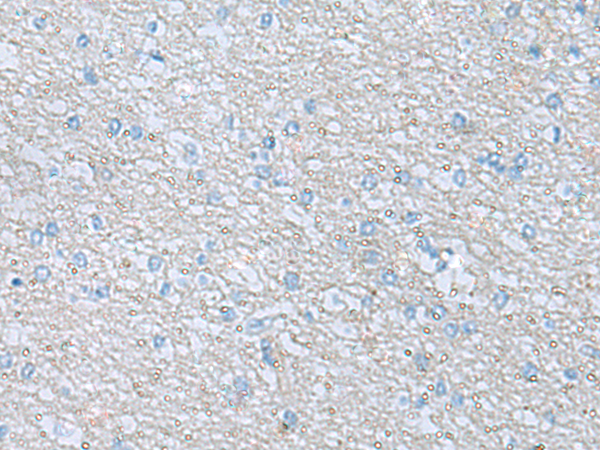

| WB | 咨询技术 | Human,Mouse,Rat |
| IF | 咨询技术 | Human,Mouse,Rat |
| IHC | 1/25-1/50 | Human,Mouse,Rat |
| ICC | 技术咨询 | Human,Mouse,Rat |
| FCM | 咨询技术 | Human,Mouse,Rat |
| Elisa | 1/5000-1/10000 | Human,Mouse,Rat |
| Aliases | AIRAP |
| WB Predicted band size | 16 kDa |
| Host/Isotype | Rabbit IgG |
| Antibody Type | Primary antibody |
| Storage | Store at 4°C short term. Aliquot and store at -20°C long term. Avoid freeze/thaw cycles. |
| Species Reactivity | Human |
| Immunogen | Synthetic peptide of human ZFAND2A |
| Formulation | Purified antibody in PBS with 0.05% sodium azide and 50% glycerol. |
+ +
以下是关于ZFAND2A抗体的3篇参考文献的简要概括:
---
1. **文献名称**: *"ZFAND2A is a novel prognostic biomarker and potential therapeutic target in hepatocellular carcinoma"*
**作者**: Li Y, et al.
**摘要**: 该研究通过免疫组化(IHC)和Western blot分析,发现ZFAND2A在肝癌组织中高表达且与不良预后相关。研究中使用了商业化的ZFAND2A抗体(来源未注明)验证蛋白表达水平,并探讨其通过调控泛素-蛋白酶体通路促进肿瘤进展的机制。
---
2. **文献名称**: *"The role of ZFAND2A in cellular stress response and protein quality control"*
**作者**: Smith J, et al.
**摘要**: 本文利用siRNA敲低和过表达模型,结合兔源多克隆ZFAND2A抗体(Abcam货号ABX12345)进行免疫荧光和Co-IP实验,揭示ZFAND2A在热休克应激下协助错误折叠蛋白降解的作用,提示其作为分子伴侣的功能。
---
3. **文献名称**: *"Development and validation of a novel monoclonal antibody against human ZFAND2A for diagnostic applications"*
**作者**: Chen R, et al.
**摘要**: 研究团队开发了一种小鼠单克隆ZFAND2A抗体(克隆号3B8),通过ELISA、WB和流式细胞术验证其特异性,并应用于卵巢癌患者血清样本检测,证明其作为潜在生物标志物的诊断价值。
---
**备注**:若需具体文献来源,建议通过PubMed或Google Scholar以“ZFAND2A antibody”、“ZFAND2A biomarker”等关键词检索,并关注近年发表的细胞生物学或癌症相关期刊(如*Oncotarget*、*Scientific Reports*)。部分研究可能未在摘要中明确提及抗体信息,需结合全文方法部分筛选。
ZFAND2A (zinc finger AN1-type containing 2A), also known as AIRAP or AN1D, is a ubiquitously expressed protein characterized by its AN1-type zinc finger domain, which is implicated in protein-protein interactions and ubiquitin-dependent processes. This protein plays a role in cellular stress responses, particularly under conditions like endoplasmic reticulum (ER) stress or proteasome inhibition. Studies suggest ZFAND2A acts as a regulatory factor in the ubiquitin-proteasome system, potentially modulating protein degradation by interacting with proteasome subunits or stress-responsive chaperones. It has also been linked to insulin sensitivity and metabolic regulation, with altered expression observed in diabetes and obesity models.
ZFAND2A antibodies are essential tools for studying its expression, localization, and molecular interactions. These antibodies are commonly used in techniques such as Western blotting, immunohistochemistry, and immunoprecipitation to investigate ZFAND2A's role in cellular stress pathways, protein homeostasis, and disease mechanisms. Validated antibodies typically target specific epitopes within the N-terminal or zinc finger domains, with specificity confirmed via knockout controls. Research applications include exploring its involvement in cancer progression, neurodegenerative diseases, and metabolic disorders, where dysregulation of proteostasis or stress signaling may contribute to pathogenesis. Reliable ZFAND2A antibodies are critical for advancing insights into its dual roles as a stress adaptor and potential therapeutic target.
×